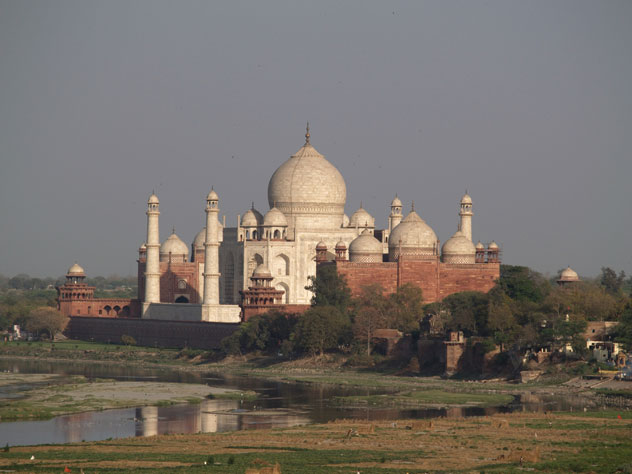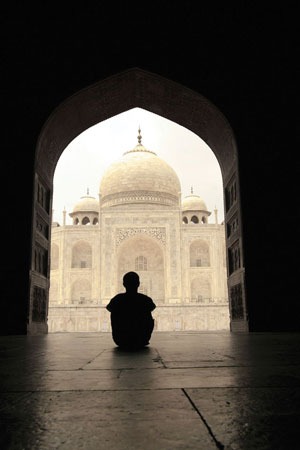ENVIRONMENT:
Landmark in Danger: The Taj Mahal Could Sink
The sheer negligence and abuse of mother nature by the urban society and industrialization has depleted and dried up the Yamuna river, causing a grave danger of India losing the Taj Mahal that could potentially sink, writes Siliconeer India correspondent Siddharth Srivastava.

(Above): A view of the Taj Mahal and the polluted environment. A dry Yamuna river is causing fears that it could break the wooden foundation of the structure that needs moisture to stay intact.
India’s poor environment protection record could permanently damage the world famous monument of love, the Taj Mahal at Agra.
Expert opinion is gaining ground that the depletion and drying of the Yamuna River could irreparably damage the magnificent monument, one of the eight wonders of the world.
According to assessments, the periodic drying of the Yamuna due to the misuse of the river and its waters as it flows along the Northern Plains could permanently weaken the foundation of the Taj and threaten the structure.
The Taj rests on the banks of the Yamuna at Agra. It was built by Mughal emperor Shah Jahan in the memory of his beloved wife Mumtaz Mahal. The structure of the Taj is propped on an ebony wood base that needs moisture to retain its strength.
Though the Taj is considered an engineering marvel and known world wide for its beautiful design and elegant marble structure, the drying of the Yamuna is a matter that Shah Jahan and the architects of the monument could never have envisaged.
The pristine waters of the Yamuna originate from the Himalayas in North India and flows through national capital New Delhi. Over time dams, barrages and canals have restricted the water flow, while deforestation along the banks has meant soil erosion and blockages.
The maximum damage is caused by the drawing of waters for industrial purposes and usage by rising populations of Haryana, Delhi and Uttar Pradesh. There is no scope for recharge as unplanned industrialization and urbanization has resulted in sewerage, waste and poisonous material being spewed back into the river.
Although the Yamuna Action Plan to restore the river with the help of Japan was launched almost two decades back, the progress has been tardy. Nearly 60% of Delhi’s sewerage continues to be dumped into the river reducing the Yamuna into a “drain.”
 (Right): A lone spectator sits in a pensive mood, enchanted by the majestic Taj Mahal. (Right): A lone spectator sits in a pensive mood, enchanted by the majestic Taj Mahal.
On a recent visit to Agra our correspondent, Siddharth Srivastava found that the river was a trickle of viscous dark grey in which no aquatic life could survive. The once ‘perennial’ river dries up completely during the summer months at Agra.
Several local movements in Agra and studies have thus been seeking to bring to mainstream notice the threat to the Taj. One such is the Save Taj campaign that has gained some momentum and has the support of environmentalists, activists, politicians, traders and businessmen.
Last month, the member of Parliament from Agra R.S. Katheria (belonging to the political outfit Bharatiya Janata Party) led a delegation to President Pratibha Patil in New Delhi and apprised her of the situation. The group impressed upon Patil the need for a ‘a decent water level in Yamuna’ to save the Taj from permanent damage.
The group pleaded that the basement of the Taj should be inspected by multiple independent agencies and the findings made public. As things stand it is only the official Archaeological Survey of India (ASI) that can access the underground chambers and that’s the way it has been for the last three decades.
Although the ASI has said all is well, the fact remains that official agencies are usually the last to own up to mistakes and that too when matters are out of control or when the media finds out.
Meanwhile, a recent book by Professor R. Nath, a social activist, Taj Mahal History and Architecture, claims that absence of the Yamuna water will dry and crack the wood on which it stands making the entire edifice unstable.
The drying of the Yamuna is just one of the myriad environment issues that the country faces in the absence of planned development and reckless and callous approach to green norms and sensitivities.
Mountain ranges such as the Aravali Hills continue to be illegally mined while forests are being destroyed by the timber lobby.
In the last couple of years, there have been attempts by environment minister Jairam Ramesh to set matters right.
However, it is never easy to get the right balance for sustainable development. For example, overzealous monitoring of coal mining has resulted in a dip in production in the past year even as demand for the resource by power producers rises.
This has forced India to rely on increasing imports of coal to feed its power plants.
The country is investing in big power projects to tide over acute electricity deficits.
India needs to protect the Taj and its heritage. While norms have been put in place to ensure that auto and industrial pollution is minimized in the vicinity of the Taj, the city of Agra itself suffers overcrowding, bad roads, power outrages and major sewerage issues.
Yet, Agra remains a global tourist hub due to the Taj and to a lesser degree due to the Agra Fort which provides a beautiful view of the monument nestled on the river bank.
Unless urgent action is taken, time may be running out for the eternal symbol of love.
|